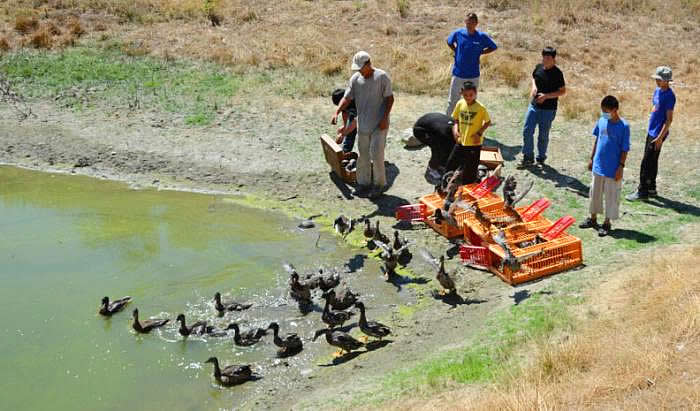 |
|
Environmental Issues: A Buddhist Perspective [1]
By Professor Ron Epstein [2]
Vajra Bodhi Sea: A Monthly Journal of Orthodox Buddhism,
v. 35, series 83, March 2005, pp. 28-31I have been asked to provide you with a general introduction to how Buddhists see environmental issues. I hope that my remarks will be useful background for our forum today. Although my assigned topic is a vast and complex one, I am going to restrict myself to a simple explanation of three basic aspects of it.
How Buddhists Understand Nature
All life is interrelated and interdependent. Nature, or we could say our natural environment, is alive and at least partly conscious. It is neither sacred and perfect nor evil and to be conquered. The deep reality of Nature is not separate from our fully enlightened nature (Buddha-nature).
Buddhists understand ‘Nature’ as a useful conventional designation without any unique, intrinsic reality of its own that absolutely distinguishes it from what is ‘not Nature’. In a less technical sense, it is the conditioned world prior to extreme human distortion of the patterns of interrelationship between humans and the rest of the living beings on the planet. It can also be understood as the living web that interconnects individual beings, both sentient and non-sentient, in interdependence. What is ultimately real about that web is its Buddha-nature, its Buddha-ness. That deep reality of Nature is not separate from our own fully enlightened nature. When we purify our minds, we experience the true nature of Nature, and then we see that we are actually living in a Pure Land or Buddhaland. That Buddhaland is not somewhere else, but right here. The Sixth Chan Buddhist Patriarch the Venerable Huineng quoted the Buddha as saying: “As the mind is purified, the Buddhaland is purified.”[3]
From the Buddhist viewpoint, humans are not in a category that is distinct and separate from other sentient beings, nor are they intrinsically superior. All sentient beings are considered to have the Buddha-nature, that is, the potential to become fully enlightened. Buddhists do not believe in treating of non-human sentient beings as objects for human consumption.

Enlightened beings do not harm sentient life. If they did, they would not be enlightened beings. They have compassion for unenlightened beings, who are attached to our polluted world, filled with pain and suffering, and who do not experience themselves as living in a pure Buddhaland.

By looking inward, within one’s own body-mind, one gradually realizes that there is no ultimate division between inside and outside, that the patterns of the natural environment are not separate from the patterns of our own body-minds. Experience of those patterns is not considered an ultimate truth or the goal of Buddhist practice, but awareness of them is an important aspect of the Path that leads to enlightenment.
Nature and the Buddhist Path to Enlightenment
Nature as wilderness is important to Buddhists because it provides a place where rapid progress in Buddhist practice, or self-cultivation, can be made.
Nature grounds us and can soothe us. Unspoiled natural locations, usually places in the wilderness where the natural energies are peaceful, are the ideal places for Buddhist practice. Here is what some traditional Buddhist sources tell us about the benefits of the natural environment as a place for Buddhist practice.
The eighth (of twelve or thirteen) ascetic practices recommended by the Buddha is dwelling in the forest. The Buddha said, I am pleased with that bhikkhu’s [monk’s] ‘dwelling in the forest’ (A. iii 343). And when he lives in a remote abode his mind is not distracted by unsuitable visible objects, and so on. He is free from anxiety; he abandons attachments to life; he enjoys the taste of the bliss of seclusion….[4]
Ajahn Mun (1870-1949), a great modern Thai Buddhist master from the forest meditation tradition had this to say about ‘staying in the wilds’:
...The more desolate and distant the place is from human habitation, with wild beasts roaming freely about, the more prepared is the mind to soar up from the abyss of defilements, being at all times like a bird about to fly. The defilements are still there in the depths of the mind, but in such an environment the power of the mind is greatly developed and appears to have gotten rid of hundreds of defilements, with only few remaining. This is the influence of environment which gives encouragement to an aspirant at all times.[5]
The Chinese Chan Master Han Shan (7 th cent. CE) wrote these two poems about living and meditating in the mountains:
Poem #22
There is a master who eats the pink clouds;
His abode shuns the haunts of the common.
As for the seasons truly crisp and cool;
In summer it’s just like the fall.
Secluded brooks--constant gurgle and splash;
Through tall pines the wind sighs and moans.
In here if you sit half a day,
You’ll forget the cares of one hundred years.
Poem #106
Layer after layer of beautiful mountains and streams;
Fog and rose-colored clouds, locking in hillsides of green.
Brushed by mountain mist, my thin cotton headband gets wet;
Morning dew dampens my raincoat of straw.
On my feet are my “traveling” sandals,
In my hand, an old branch of cane.
Again I gaze beyond the dusty world;
A realm of dreams why should I bother with that any more.[6]I think that almost all of us have had experiences that allow us to appreciate the sentiments expressed in those poems.
Nature, Karma and Buddhist Ethics
The core of Buddhist karma-based ethics is respect for life, particularly sentient life. On the everyday level of understanding, Nature changes according to the karma (patterns of intentional causal activities and their consequences) of all sentient beings. Mental pollution causes environmental pollution, and environmental pollution fosters mental pollution.
The starting place for understanding just about anything about Buddhism is karma. Karma is the causal network of intentional actions, both mental and physical, that is the foundation of Buddhist ethical understanding. The foremost principle of Buddhist karma-based ethics is ahimsa, the principles of non-harming and of respect for life. This does not only refer to respect for human beings, but also for every manifestation of life on the planet, especially sentient life.
As one’s mind is purified, one’s actions are purified. As a result, not only do mental attitudes that are dissonant or harmful to Nature disappear, but one’s new mental states lead directly to more enlightened actions in relation to Nature and more enlightened influence on others about Nature.
There is also influence from action to mind. As we act more responsibly towards life in Nature or life as Nature, the more our actions will purify and clarify our minds. Consideration of our actions and their consequences will lead us to more environmentally responsible ethical behavior.

Buddhist monks and nuns vow to follow moral precepts that prohibit harming of the environment. There are vows for protecting the purity of the water; for not killing sentient beings who live in the earth; for not killing insects, birds, and animals; for not starting forest fires; and for respecting the life of trees, particularly ancient ones.
In the contemporary world, Buddhist monastic communities are developing a new ways of applying ancient Buddhist principles to their own environments. For example, in the Dharma Realm Buddhist Association, monks, nuns and lay people are getting involved in recycling; in teaching temple residents and the supporters of temples not to pollute their air, earth, and water; and in reforesting temple properties.

While performing the ancient Buddhist rite of rescuing birds and animals originally consigned to death and liberating them, they are developing a new ecologic concern for making sure that those sentient beings are released into environmentally suitable habitats. The principles of compassionate ecology are also being taught in the Association’s Buddhist schools.
In closing, I would like once again to stress the importance of the preservation of the unsullied natural world as a place for practice on the Path to enlightenment. The Buddha said this about what he himself had experienced:
There I saw a delightful stretch of land and a lovely woodland grove, and a clear flowing river with a delightful forest so I sat down there thinking, ‘Indeed, this is an appropriate place to strive for the ultimate realization of that unborn supreme security from bondage, Nirvana .’[7][1] Based on a talk given at the ‘Thinking Green, Celebrating Green’ Forum, City of Ten Thousand Buddhas, Talmage , California, December 18, 2004.
[2] Ron Epstein is a Research Professor at the Institute for World Religions in Berkeley, California. He has taught at Dharma Realm Buddhist University, University of California at Davis, and San Francisco State University, and has written extensively on both Buddhism and environmental ethics.
[3] The Sixth Patriarch’s Dharma Jewel Platform Sutra , 3rd edition, p . 184.
[4] Buddhaghosa (ca. 5 th cent. CE). The Path of Purification , II, 54, 55.
[5] The Venerable Phra Acharn Mun Bhuridatta Thera, Meditation Master , p . 41.
[6] Translations by Robert G. Hendricks, The Poetry of Han-Shan : A Complete, Annotated Translation of Cold Mountain.
[7] Ariyapariyesanaa Sutta, Majjhima Nikaaya, 26; quoted in Donald K. Swearer, ‘”Rights” Because of Intrinsic Nature or“Responsibilities Because of Mutual Interdependence,’ p. 90 IN Buddhist Perspectives on the Earth Charter, 1997.










